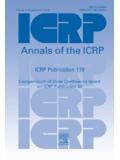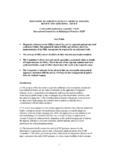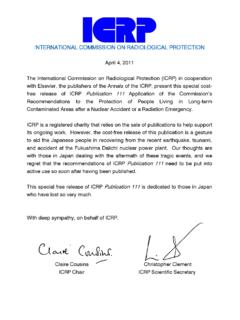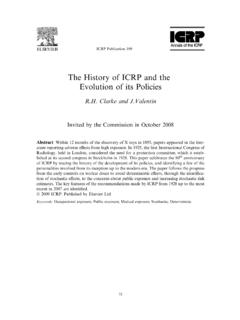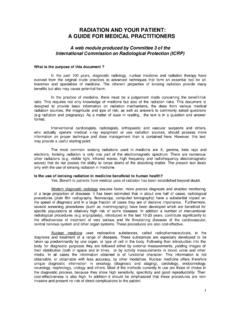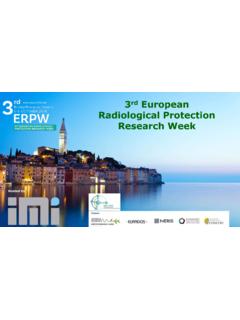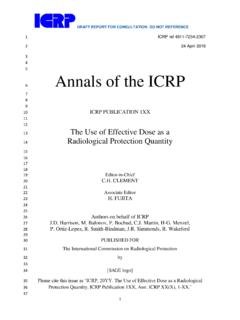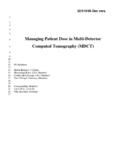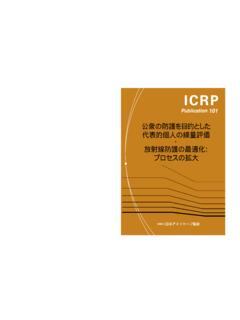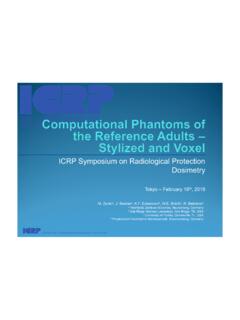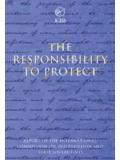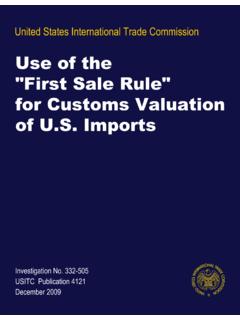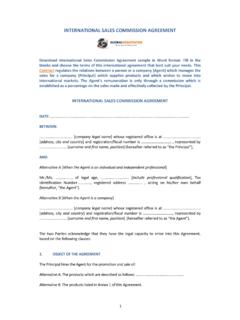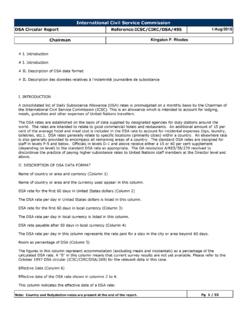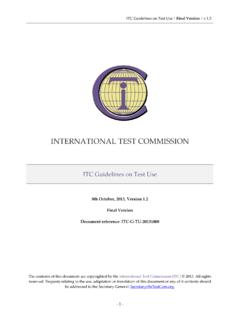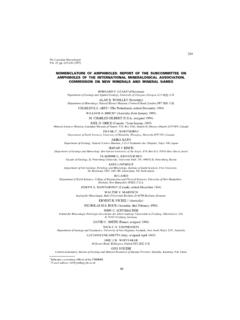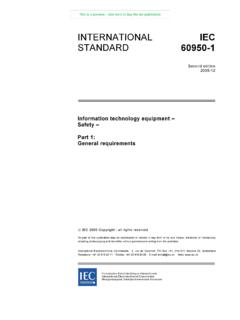Transcription of INTERNATIONAL COMMISSION ON RADIOLOGICAL …
1 - 1 (12) - INTERNATIONAL COMMISSION ONRADIOLOGICAL PROTECTION:HISTORY, POLICIES, PROCEDURESBo Lindell , H John Dunster , and Jack Valentin ( Swedish Radiation Protection Institute (SSI), SE-171 16 Stockholm, Sweden) National RADIOLOGICAL Protection Board, Chilton, Didcot, Oxon OX11 0RQ, UK INTERNATIONAL COMMISSION on RADIOLOGICAL Protection (ICRP), SE-171 16 Stockholm, Sweden- 2 (12) -AbstractThis report briefly reviews the history, mode of operation, concepts, andcurrent policies of the INTERNATIONAL COMMISSION on RADIOLOGICAL Protection (ICRP).
2 It touchesupon the objectives of the COMMISSION s recommendations, the quantities used, the biologicalbasis of the COMMISSION s policy, the quantitative basis for its risk estimates, the structure ofthe system of protection, some problems of interpretation and application in that system, andthe need for stability, consistency, and clarity in the COMMISSION s IntroductionThe INTERNATIONAL COMMISSION on RADIOLOGICAL Protection(ICRP) recently issued a review of its history, mode of operation, concepts, and currentpolicies[1].
3 The present paper summarises that report. It is assumed that the reader is broadlyfamiliar with the current Recommendations and Publications of the History and affiliationICRP was established in 1928 as a COMMISSION linked tothe INTERNATIONAL Congresses of Radiology. Formally, its parent organisation is still theInternational Society of Radiology, but its field of work has widened from protection inmedical radiology to all aspects of protection against ionising radiation. The COMMISSION issupported by a number of INTERNATIONAL organisations and by many governments.
4 It issuesrecommendations on the principles of radiation protection. Its recommendations form the basisfor more detailed codes and regulations issued by other INTERNATIONAL organisations and byregional and national COMMISSION is registered as an independent charity in the United Kingdom and isfinanced mainly by voluntary contributions from INTERNATIONAL and national bodies with aninterest in RADIOLOGICAL protection. Some additional funds accrue from royalties on theCommission s publications.
5 Members institutions also provide financial support to theCommission by making the members time available without charge and, in some cases,contributing to their costs of attending meetings. Many of these institutions also providesubstantial resources without charge to the COMMISSION issued its first report in 1928. The first report in the current series,subsequently numbered Publication 1[2], contained recommendations adopted in September1958. Subsequent general recommendations have appeared in 1964 as Publication 6[3], in 1966as Publication 9[4], and in 1977 as Publication 26[5].
6 Publication 26 was amended and extendedby a Statement in 1978[6] and further clarified and extended by a succession of Statementsbetween 1980 and 1987[7, 8, 9, 10, 11]. The recommendations were completely revised and issued in1991 as Publication 60[12]. Reports on more specialised topics have appeared as intermediateand subsequent Publication numbers. The more recent reports are listed in Table 3 (12) -The COMMISSION has always been an advisory body. It offers its recommendations toregulatory and advisory agencies at INTERNATIONAL , regional, and national levels, mainly byproviding guidance on the fundamental principles on which appropriate RADIOLOGICAL protectioncan be based.
7 The COMMISSION does not aim to provide regulatory texts. Authorities need todevelop their own texts in the context of their own regulatory structures. Nevertheless, theCommission believes that these regulatory texts should be developed from, and have aims thatare broadly consistent with, its guidance. In addition, the COMMISSION hopes that its advice isof help to management bodies with responsibilities for RADIOLOGICAL protection in their ownoperations, to the professional staff whom they use as their advisers, and to individuals, such asradiologists, who have to make decisions about protection in the use of ionising The Structure and Mode of Operation of the CommissionICRP is composedof a Main COMMISSION and four standing Committees.
8 The COMMISSION consists of twelvemembers and a Chairman. They are elected by the COMMISSION itself, under its rules, which aresubject to the approval of the INTERNATIONAL Society of Radiology. The Committee members areappointed by the COMMISSION , and each Committee is chaired by a COMMISSION member. From1962 to the present, 1998, there have been four Committees: Committee 1 on RadiationEffects, Committee 2 on Derived Limits, Committee 3 on Protection in Medicine, andCommittee 4 on the Application of the COMMISSION s COMMISSION uses Task Groups and Working Parties to prepare reports to bediscussed by the Committees and finally approved by the COMMISSION .
9 Task Groups areappointed by the COMMISSION to perform a defined task, usually the preparation of a draftreport. A Task Group usually contains a majority of specialists from outside the COMMISSION sstructure. Working Parties are set up by Committees, with the approval of the COMMISSION , todevelop ideas for the Committee, sometimes leading to a Task Group. The membership isusually limited to Committee COMMISSION s secretariat is managed by a Scientific Secretary with a minimum The Objectives of the COMMISSION s RecommendationsThe main objectiveof the COMMISSION s recommendations is to provide an appropriate standard of protection forman without unduly limiting the beneficial practices giving rise to radiation aim of providing an appropriate standard of protection, rather than the bestpossible standard regardless of costs and benefits.
10 Cannot be achieved on the basis of scientificconcepts alone. Members of the COMMISSION and its Committees have the responsibility forsupplementing their scientific knowledge by value judgements about the relative importance ofdifferent kinds of risk and about the balancing of risks and benefits. The COMMISSION believes- 4 (12) -that the basis for such judgements should be made clear, so that readers can understand howthe decisions have been QuantitiesThe absorbed dose is the radiation energy imparted per unit mass of anirradiated body.
